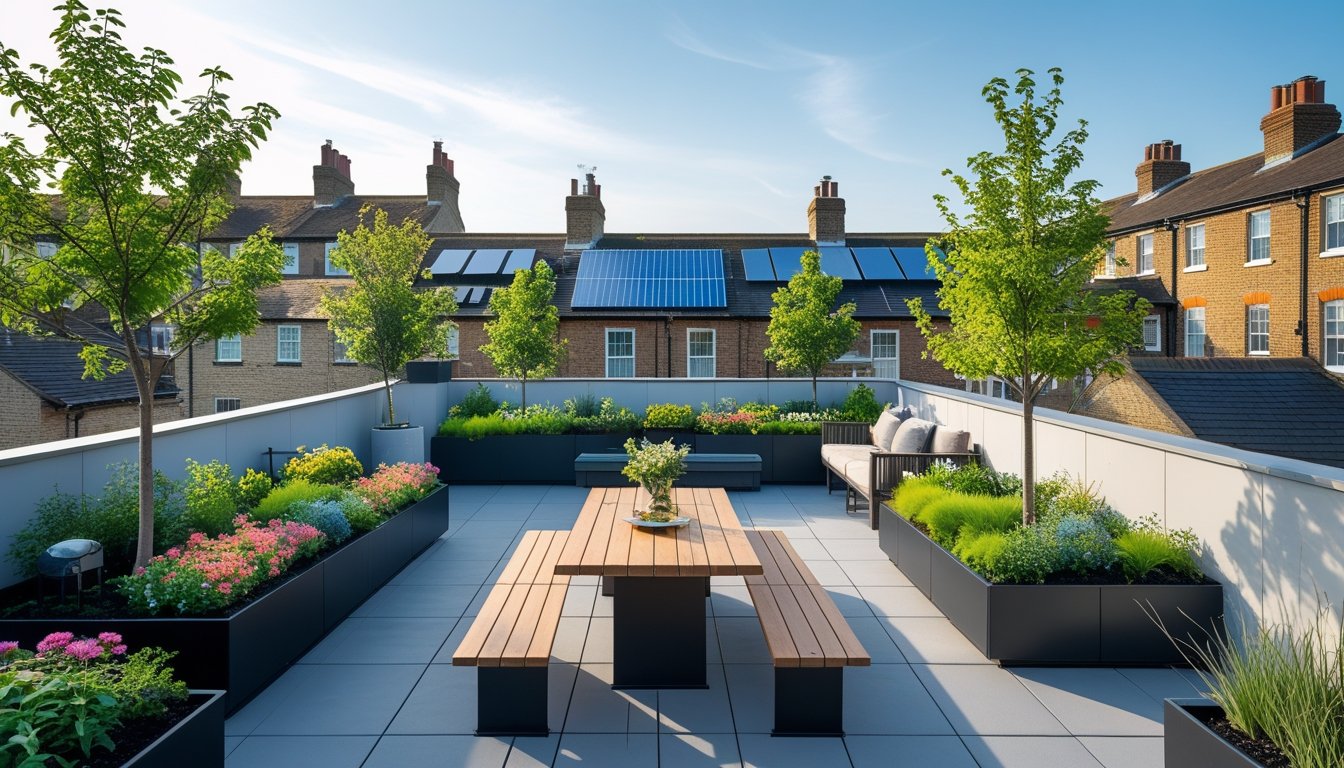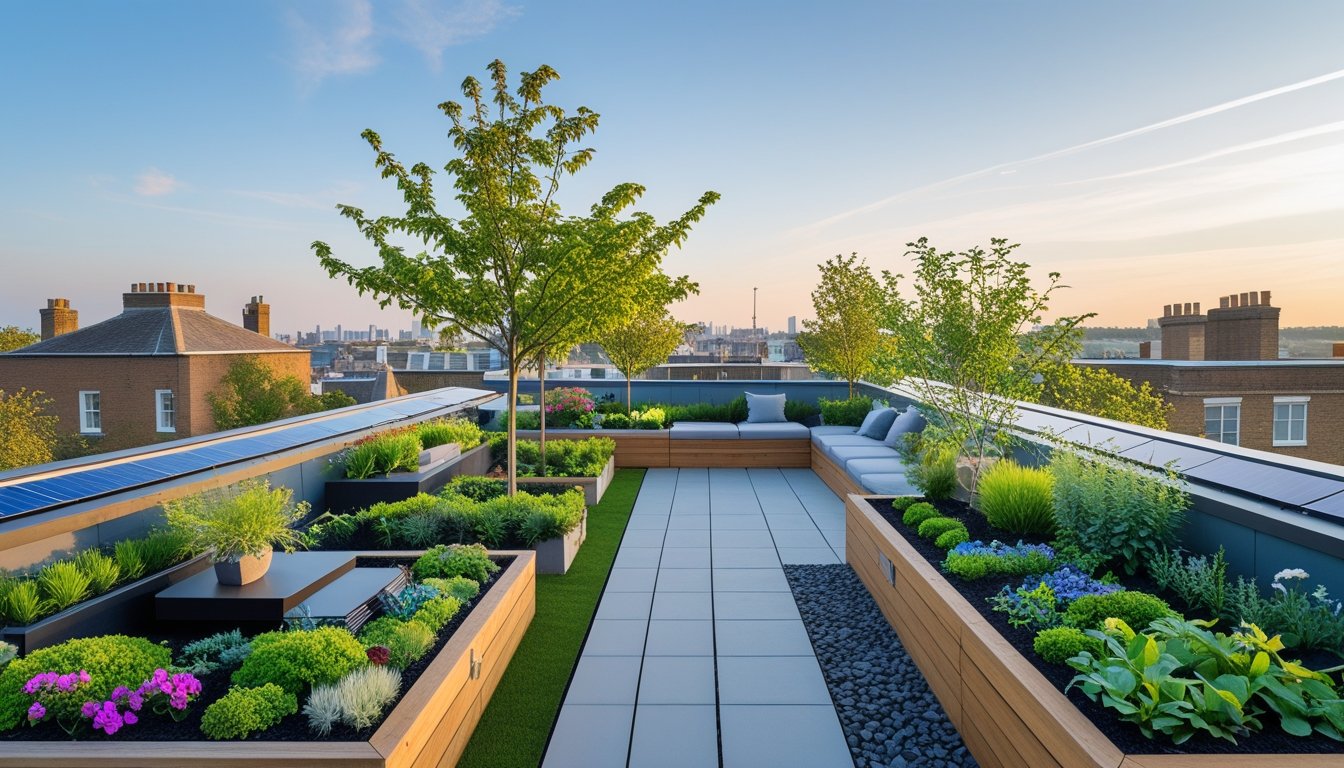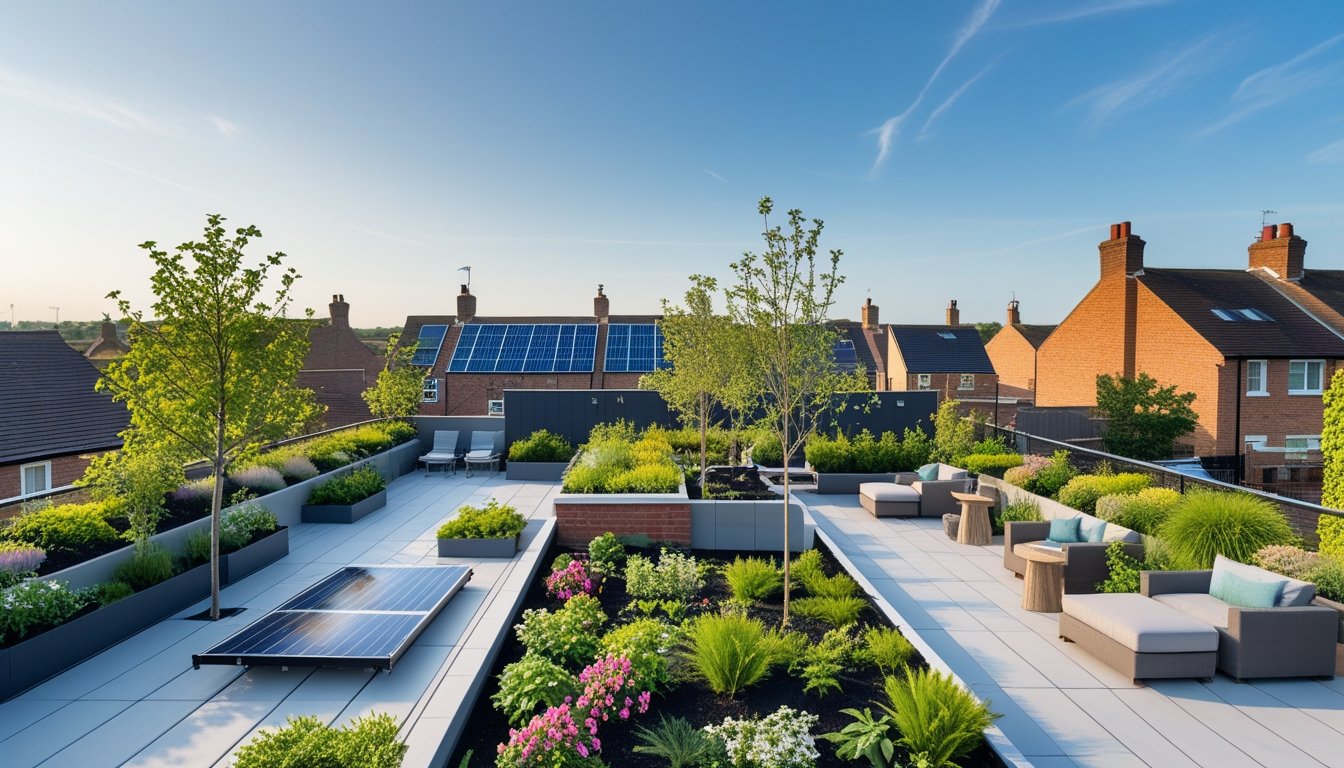Late updated: 31 Jul 2025 14:07
Written by: Oliver Bennett
Innovative Roof Garden Concepts For UK Homes: Transforming Urban Spaces
In recent years, incorporating greenery into urban living spaces has gained significant momentum, and roof gardens have become a popular choice for many UK homeowners. These elevated sanctuaries offer a perfect escape from the chaotic city life and can significantly enhance the aesthetic and environmental value of your home. Incorporating innovative roof garden concepts not only brings spectacular views but also maximizes limited space, providing an enriching outdoor experience right at your doorstep.

Creating a roof garden in the UK involves unique design principles, focusing on functionality, beauty, and sustainability. From lush green spaces to cosy retreats, the possibilities are endless. Modern advancements allow for creative installations, like raised beds and privacy screens, which add practicality and charm. With the right approach, we can transform any rooftop into a vibrant living space that suits our tastes and environmental goals.
The appeal of roof gardens lies in their adaptability and innovative design solutions. Whether it's technical innovations or developing sustainable practices, these gardens are a testament to how we can breathe new life into urban spaces. As we dive deeper into this topic, we'll explore more about the intriguing world of roof garden design that's revolutionising homes across the UK.
Key Takeaways
- Innovative roof gardens enhance home aesthetics and green spaces.
- Key design principles include functionality and sustainability.
- Modern solutions offer creative and eco-friendly roof garden options.
Key Design Principles for Innovative Roof Gardens

Innovative roof gardens blend creativity with functionality, maximising the potential of urban spaces. They offer not just aesthetics but also practical benefits like sustainability and increased property value. Key aspects include efficient space utilisation, smart plant choices, and the clever use of structural elements for privacy and comfort.
Maximising Roof Space in Urban Homes
When designing roof gardens, it's crucial to maximise the available space, especially in urban homes where space is premium. The goal is to create a dynamic environment without overcrowding. We can employ multi-level planting to maximise vertical space, which lets us incorporate a wider variety of plants. Using modular and lightweight furniture also helps utilise the area practically while maintaining flexibility.
Careful zoning can define specific areas for different purposes, such as lounging or dining. By doing so, we avoid a cluttered appearance and ensure each section serves its intended function. Using built-in seating or integrated planters can effectively save space, giving us a polished finish without wasting valuable rooftop real estate.
Plant Selection: From Sedums to Ornamental Grasses
Plant selection is pivotal in creating a successful roof garden. We often start with sedums for their hardiness and low maintenance, making them ideal for rooftop environments. Their ability to thrive in minimal soil is advantageous. Ornamental grasses offer versatility and beauty with their varying heights and textures, providing movement and interest throughout the seasons.
It's important to consider the specific microclimate of each rooftop. Sunlight, wind, and temperature variations can significantly influence plant health. Choosing a combination of drought-resistant and native species can improve sustainability, ensuring plants thrive year-round while requiring minimal upkeep, which is essential in urban settings where time and resources may be limited.
Creating Privacy with Trellis, Pergolas, and Fencing
Privacy is often a prime concern for rooftop gardens in densely populated areas. Trellises provide an excellent solution for growing climbing plants and adding a natural screen. We can employ pergolas to create shaded areas that offer both comfort and seclusion. These structures support climbing plants and define spaces within the garden.
Fencing is another practical approach, offering sturdiness and the possibility of additional noise reduction. A combination of these elements can simultaneously ensure privacy and enhance the garden's visual appeal. Selecting materials that complement the home’s architecture creates cohesion between the garden and the larger aesthetic environment.
Technical Innovations and Sustainability Solutions
We are exploring a blend of innovations that significantly enhance the functionality and environmental impact of roof gardens across the UK. These advancements not only improve biodiversity and air quality but also address structural integrity and energy efficiency in a meaningful way.
Establishing Green Roofs for Biodiversity and Air Quality
Green roofs are pivotal in promoting biodiversity and improving air quality. By incorporating native plant species, we can create a habitat for local wildlife, including birds and insects. This rich biodiversity supports pollination and pest control naturally.
Additionally, green roofs play a role in reducing the urban heat island effect. They help to cool the environment by absorbing sunlight and converting it into energy for photosynthesis. Plants can filter pollutants and carbon dioxide from the air, providing cleaner, healthier atmospheres.
These eco-friendly terraces enhance the aesthetic appeal of urban settings while fostering sustainability.
Essential Structural and Waterproofing Considerations
The structural integrity of green roofs demands careful planning. Involving a structural engineer ensures the roof can support the additional weight of soil, plants, and water. Assessing load-bearing capacities is a critical step.
Waterproofing protects the underlying structures from moisture. Utilising high-quality waterproof membranes reduces the risk of leaks and prolongs the lifecycle of the roof. Effective drainage systems are essential to manage rainfall and prevent water accumulation.
Thorough design and installation ensure durability and functionality over time. Properly installed systems prevent water from seeping through, maintaining the structure’s integrity.
Integrating Decking, Outdoor Kitchens, and Furniture
Roof gardens can be versatile spaces for leisure and social gatherings. Integrating decking provides a stable surface that can withstand weather conditions. Wood and composite materials are popular choices for decks due to their durability.
Outdoor kitchens and furniture add functionality and aesthetic appeal. Weather-resistant materials such as stainless steel and treated wood ensure longevity. Flexible seating arrangements cater to different sizes of gatherings, enhancing the usability of these spaces.
Creating a comfortable and inviting environment encourages outdoor living whilst maximising the space available on green roofs.
Enhancing Energy Efficiency with Solar Panels and Insulation
We can achieve significant energy efficiency gains by integrating solar panels into roof gardens. These panels harness solar energy, reducing dependence on traditional power sources. It leads to lower energy bills and a reduced carbon footprint.
Insulation is another critical component. It helps regulate indoor temperatures by minimising heat loss in winter and reducing heat gain in summer. This creates a more comfortable living environment and contributes to energy savings.
By aligning with sustainable energy practices, we can optimise roof garden designs for maximum efficiency and environmental benefit.
Frequently Asked Questions

Creating a roof garden in the UK presents unique challenges and opportunities. Our focus includes plant selection for rooftops, designing sustainable gardens in urban centres, understanding climate considerations, and implementing innovative space-saving techniques.
What are the best plants to cultivate on a UK roof terrace?
Choosing plants for a UK roof terrace requires consideration of the climate and exposure. Ideal options include hardy perennials, grasses, and shrubs that withstand wind and varying temperatures. Lavender, ornamental grasses, and sedums offer beauty and resilience.
How can one design a sustainable rooftop garden in an urban UK environment?
Sustainable design relies on efficient use of resources and environmentally friendly materials. Installing water-efficient irrigation systems and opting for native plants can significantly reduce maintenance needs. Green roofs also help insulate buildings, reducing energy consumption.
What considerations are essential for setting up a rooftop lawn in the UK's climate?
In the UK's wet climate, drainage and waterproofing are critical when establishing a rooftop lawn. A structured layer beneath the grass ensures water does not accumulate, preventing damage. Selecting grass blends adapted to shade and temperature fluctuations enhances lawn health.
What are innovative approaches to maximising space in small roof gardens?
Maximising space involves clever use of vertical gardening techniques and multifunctional furniture. Wall planters and hanging gardens increase plant coverage without taking up valuable floor space. Modular seating with built-in storage adds practicality and charm.
How can one ensure safety and compliance with UK building regulations when creating a roof garden?
Safety and compliance involve structural assessments and adherence to local regulations. Engaging with qualified professionals ensures the roof supports additional weight. Additionally, features such as railings meet safety standards while maintaining aesthetic appeal.
What are some unique design elements to include in a roof terrace in London?
Incorporating elements like contemporary pergolas or glass balustrades brings a modern feel to London terraces. Custom lighting can transform the space into an inviting evening retreat. Using local materials ensures the design reflects the city’s character and heritage.
